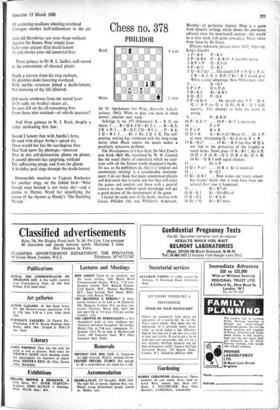Chess no. 378
PHILIDOR
Black White 4 men 3 men
Dr W. Speckmann (1st Prize, Deutsche Schoch- zeitung, 1961). White to play and mate in three moves; solution next week.
Solutign to no. 377 (Ellerman): K - R 5!, no threat. 1 B - Q 4; 2 Q - Kt 2. I . . . B - K 5;
2R x P. 1 B - Q 2; 2 Q - B 5. 1 P - K 4; 2 Q - B 1. 1 . . . Kt x Kt; 2 Q x R. The self- pinning, waiting key combined with the long-range mates when Black unpins the queen makes peculiarly attractive problem.
The Development of Chess Style, Dr Max Euwe's new book (Bell 30s, translated by W. H. Cozens) has the usual clarity of exposition which we asso- ciate with all the former world champion's books. To say, as the publishers do, that it is 'original and enormously exciting' is a considerable overstate- ment; I do not think that many experienced players will find much that is really new but they will enjoy the games and analysis and those with a general interest in chess without much knowledge will get a good picture of the development of the game.
I found the early part of the book—dealing with Greco, Philidor (the true Philidor!), Anderssen,
Morphy—of particular interest. Here is a game from Greco's writings which shows the enormous advance since the seventeenth century—this would be a very weak club game nowadays. Notes taken from those by Dr Euwe.
[Players unknown; played about 1625). Opening, King's Gambit.
1 P-K 4 P-K 4
2 P-KB4 P- K B 4? A horrible move.
3 KP X P Q-R 5 ch 4 P - Kt 3 Q - K 2
5 Q - R 5 ch? ... The simple 5 P x P. Q x Pch; 6 B- K 2, Q X B P; 7 Kt - B 3 would give White a clear advantage. Now White loses time. 5...K - Q 1
6 PxP QXP ch 7 B - K 2 Kt- KB 3 8 Q-B 3 P-Q4
9 P- K Kt 4 . . . He should play 9 P - Q 4, Qx BP (or Q x Q P); 10 B - Q 3 with equality. This attempt to hold the pawn is wrong.
9 . . . P - K R 4!
10 P K R 39 . . 10 P - Kt 5 is necessary.
10 . . . P x P
11 P x P R x R 12 Q x R Q- Kt 6 ch? Better 12 .. . Kt X P
at once, threatening Q - Kt 6 ch or B x P.
13 K - Q I? ... 13 Kt - B I! (so that W Q is not tied to the protection of the knight) is much better. Euwe gives 13 K - B 1 !, Kt X P; 14Q x P ch, B - Q 2; 15B x Kt. Q X B;
16 Kt - Q B 3 with equal chances.
13 . . . Kt x P 14 Q x P ch? . . . 14 B x Kt is essential.
14 . . . B - Q 2
15 Kt - K B 3 . . . Now comes our 'every school- boy knows' finish—but it must have been sen- sational first time it happened.
15 . . . Kt - B 7 ch
16 K - K 1 Kt - Q 6 dble ch 17 K-Q I Q-K 8ch 18 Kt x Q Kt - B 7 mate










































 Previous page
Previous page